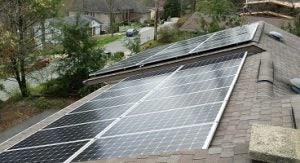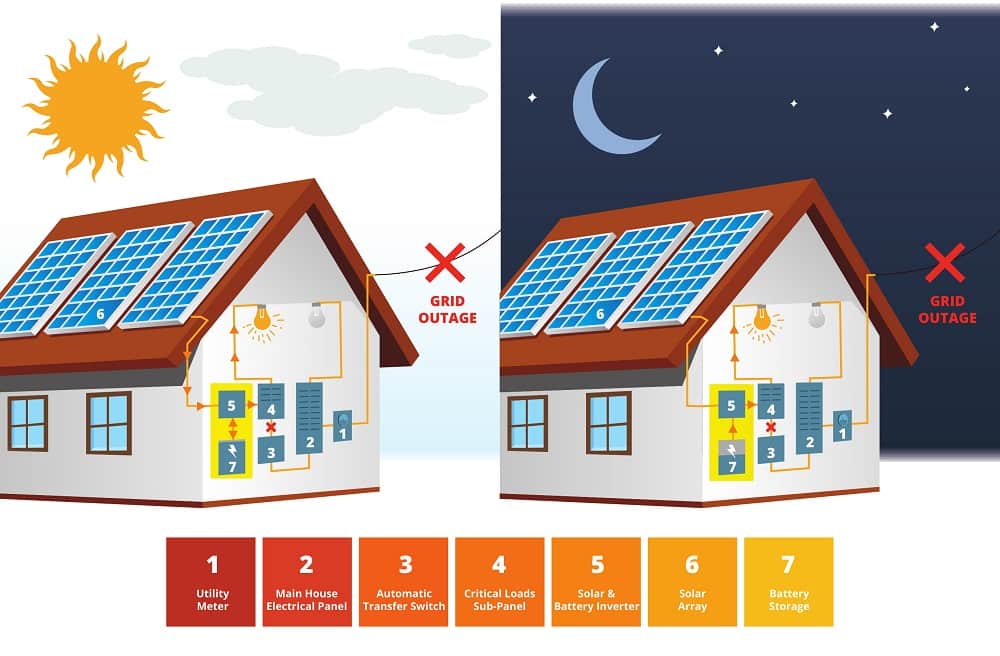- +254 (0)707 702387
- info@jemysun.co.ke
- Mon - Fri: 08:00 a.m - 05:00 p.m
Do you have questions about solar energy? Our FAQs are designed to give you an overview of solar technology, solar installation, and solar economics, so you’ll have the confidence to go solar.
Solar panels are made up of photovoltaic (PV) cells made of silicon. When the sun’s rays hit them, these cells convert sunlight to electricity. Individual cells are wired together to form a solar panel. Panels are typically three feet by five feet. They are coated in tempered glass, which allows them to withstand harsh weather.
 The electricity produced by a single solar panel is not enough to power a home or business, so multiple solar panels are needed. The number of panels varies by installation, but every solar system (also called an “array”) will include a series of panels mounted and wired together. This array may be installed on a roof (“rooftop solar”) or on the ground-level (“ground-mounted solar”).
The electricity produced by a single solar panel is not enough to power a home or business, so multiple solar panels are needed. The number of panels varies by installation, but every solar system (also called an “array”) will include a series of panels mounted and wired together. This array may be installed on a roof (“rooftop solar”) or on the ground-level (“ground-mounted solar”).
The electricity generated by solar panels takes the form of direct current (DC). However, most appliances and electricity-consuming objects (called “electric load”) require alternating current (AC). To convert the solar electricity from DC to AC, an inverter is needed. You will need to choose between two types of inverters: a central inverter and microinverters. While both perform the task of converting electricity from DC to AC, they differ in critical ways.
The size of your optimal solar array will be influenced by many variables. Before analyzing those variables, you should understand how solar is sized and measured. The electrical capacity of solar panels is measured in watts (W). The typical solar panel is rated at 250-300 W. To get the total power (in watts) of your solar array, add together the wattages of each panel. Let’s say you had 10 300 W panels installed. The total wattage of your system would equal 3,000 W. 1,000 W is equal to 1 kilowatt (kW), so another way to describe the size of that system would be 3 kW. The average size of a solar array is 5 kW.
Your installer will estimate how many panels can fit on your roof given its footprint and shade susceptibility to determine the ideal size of your system. If the size of your roof is limited (meaning fewer panels can be installed), installers can compensate by offering high-efficiency panels. These panels will have a higher power rating (typically 300-350 W), and therefore will produce more electricity per panel. Installers will also use geospatial data to determine the optimal system size for your property, as roof orientation and climate factors will affect how much electricity your system produces. The final factor that will influence the size of your solar array is your project budget. Installers work closely with clients to maximize the amount of solar they install for the customer’s budget.
While sizing your solar array, installers will consider how much the solar electrical output will offset your electricity needs. While the power capacity of solar panels is measured in watts (or kilowatts), the amount of electricity produced by the panels is measured in watt-hours (or kilowatt-hours).
Solar is a simple, minimum-maintenance technology. Unlike other energy technologies, solar PV contains no moving parts. This means it’s not likely your equipment will fail. You should not have to replace your panels at all during their lifetime. Wiring is the part of solar PV that most commonly requires maintenance because squirrels and other animals may tamper with it. Depending on your inverter type, you may also need to have your inverter replaced 10 to 12 years after installation. Extended warranties can cover this equipment replacement cost. Ask your installer for details.
In most cases, solar panels do not need to be washed, as rain and snow naturally clean them. In areas with less rain and lots of dust or pollutants in the air, occasional cleaning may improve performance. We do not recommend climbing up to your panels to wash them. If you live in an area where cleaning is needed, contact a solar professional.
Even though solar is low maintenance, we recommend asking your installer or another qualified solar professional to inspect your array every 3 to 5 years to make sure things remain in good operating order. They’ll do a visual inspection of all equipment, check for things like wire damage from critters, and make sure your system is performing properly.
Most solar arrays don’t have batteries- yet. Most residential solar arrays in the United States remain grid-tied, meaning they’re connected to the utility electric grid. Grid-tied solar arrays are significantly less expensive than arrays with batteries. Standalone solar arrays are also more efficient than solar paired with storage. Batteries lose a small amount of their electrical charge as the current moves through them, making battery-paired solar arrays slightly less efficient that standalone solar.

© 2025 JEMYSUN ENERGY SOLUTIONS LIMITED.